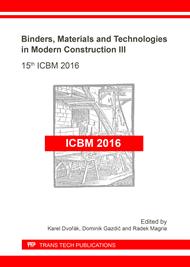p.94
p.100
p.106
p.111
p.118
p.123
p.129
p.134
p.139
Physical Properties of Building Blocks from Hemp Shives Aggregate and Cementitious Binder, Manufactured in the Expanded Clay (Vibro Pressing) Production Line
Abstract:
Scientific literature mostly aims at investigation of composites with fibre hemp shives (FHS) aggregate and lime binder, although, such materials are characterised by pretty low mechanical properties. In order to obtain higher mechanical properties of a composite, it is appropriate to use cementitious binder. This work investigates physical properties of blocks from hemp shives aggregate and cementitious binder, manufactured in the expanded clay production line using vibro pressing technology. Following properties of the blocks are determined: freeze-thaw resistance, compressive strength, thermal conductivity and density. Thermal resistance according to EN ISO 6946 for the block with cavities is calculated as well. It is found that compressive strength of FHS-cement blocks may be up to 3.18 MPa when the density is of ~850 kg/m3 and thermal conductivity up to 0.135 W/(m∙K). It is found as well that the decrease of compressive strength is 8.7% after 25 freeze-thaw cycles.
Info:
Periodical:
Pages:
118-122
Citation:
Online since:
October 2017
Authors:
Keywords:
Price:
Сopyright:
© 2017 Trans Tech Publications Ltd. All Rights Reserved
Share:
Citation:


